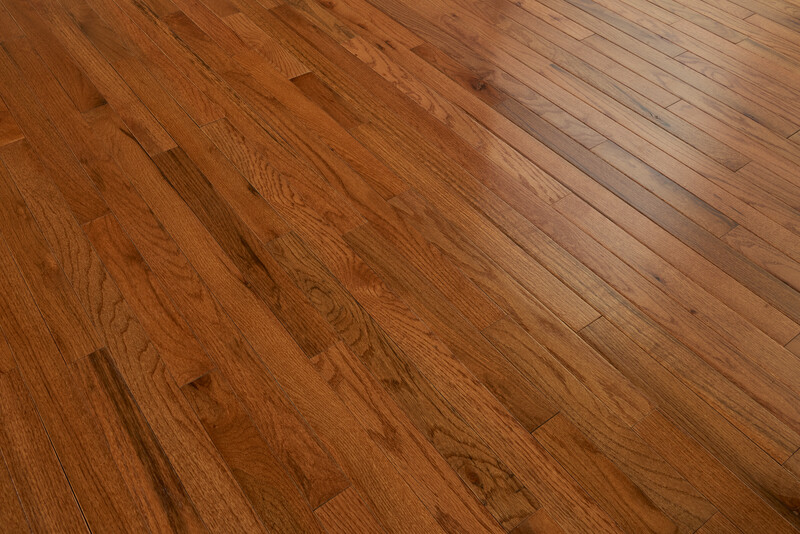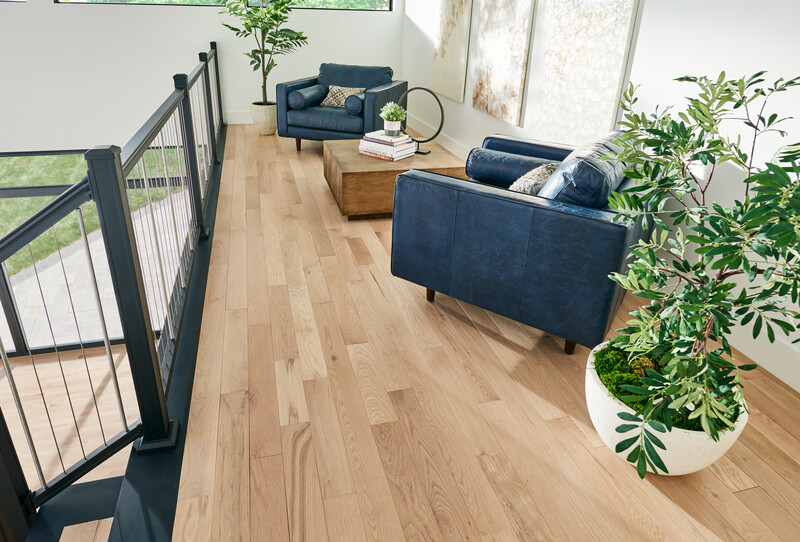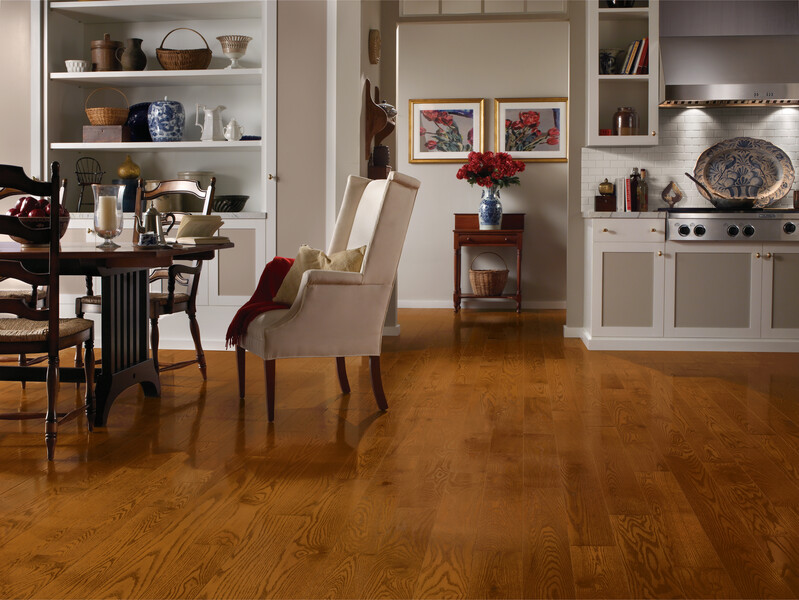The Complete Guide to Oak Hardwood
April 25, 2025
Oak hardwood is one of American homes’ most enduring and versatile flooring choices. Its strength, classic look, and broad design appeal make it a favorite for traditional and modern interiors.
This complete guide breaks down everything you need to know about oak hardwood. We’ll cover everything from solid oak floorboards and species differences to coloration, installation, and care. If you’re considering oak flooring, this guide will help you make a confident and informed decision.

Why Choose Oak Hardwood?
It’s simple. Oak hardwood has long been a favorite thanks to its durability, natural beauty, and versatility. Oak is also a domestic species widely available across the United States. That availability keeps costs more manageable compared to some exotic wood species, while still delivering high performance.
The closed grain of oak contributes to its strength and wear resistance, making it ideal for high-traffic areas. Oak also stains well, so you can customize it to suit a variety of colors and finishes—from classic light brown to deeper, richer tones.
Oak in the Market and the Forest
Oak flooring isn’t just a timeless design choice—it’s also the most widely used species in hardwood flooring today. Red oak alone accounts for about 35.8% of the U.S. hardwood flooring market, making it the top species in use across residential and commercial projects. Its durability, affordability, and visual warmth blend make it an easy favorite (Source: IMARC Group).
From an eco-friendly standpoint, oak—particularly red oak—is a smart environmental choice. The U.S. red oak growing stock estimates sit at 2.62 billion cubic meters. Moreover, it’s growing faster than foresters can harvest it.
The popular species grows at a rate of 60.6 million cubic meters annually. However, its harvesting rate is 31.9 million cubic meters, creating a net annual increase of 28.7 million cubic meters (Source: Holmes Flooring). This natural surplus reinforces oak’s reputation as a renewable, responsible flooring material.
Types of Oak: Red Oak vs White Oak
Choosing the correct type of oak hardwood starts with understanding the difference between red oaks and white oaks. These two offer distinct appearances and characteristics. Knowing how they compare can help you make the best decision for your space.
Generally, red oak varieties offer a classic look with more grain variation. White oak, on the other hand, tends to feel more modern and refined.
Red Oak Offers a Pronounced Grain Pattern
Let’s start with red oak, the most widely used species in the flooring industry today:
- Comes from the red oak tree, common throughout the eastern United States
- Has a warmer, pinkish undertone
- Features a more pronounced grain pattern
- Slightly less dense than white oak, but still durable
- Generally more affordable
White Oak Has a Tighter, Straight Grain
Now let’s shift to white oak hardwood. This version of oak flooring offers a denser, more water-resistant alternative. White oak has become a favorite in modern and minimalist design settings.
- Comes from white oak trees, also native to North America
- Cooler color than red oak with a more yellow or gray cast
- Tighter, straighter grain
- More dense and water-resistant with a closed grain structure
- Slightly more expensive because of its higher density and performance
Solid Oak Flooring vs Engineered Options
Solid oak floorboards and engineered oak flooring each have different strengths, making them suitable for different types of installations and lifestyles.
Solid Oak Floorboards
Solid oak flooring is the traditional gold standard for hardwood floors. Crafted from a single piece of oak, it offers unmatched authenticity and delivers longevity that homeowners have relied on for generations.
Solid oak can handle decades of use. Plus, once worn, you can sand and refinish oak hardwoods to gain even more decades. For example, Bruce® Dundee® oak hardwoods include a 50-Year Finish and Lifetime Structural Warranty. They include a Dura-Luster® Plus finish, a multi-layer finish offering the highest level of protection.

Here’s what to expect with solid oak flooring:
- Made from a single piece of wood
- Can be sanded and refinished multiple times
- Best for above-grade installations where humidity is controlled
- Offers maximum longevity (50+ years with proper care)
Engineered Oak Flooring
Engineered oak flooring preserves oak’s natural beauty while making it more adaptable to today’s diverse living environments. Engineered hardwood uses a top layer of real oak over a stable plywood core.
The result? A hardwood floor built to handle humidity and temperature changes better than solid wood. Engineered hardwood flooring is smart for basements, condos, or homes with radiant heat systems.
- Made from a top veneer of oak hardwood with a plywood core
- More stable in environments with moisture or temperature fluctuations
- Suitable for basements, condos, and radiant heating systems
- Slightly less longevity but still long-lasting
Oak Coloration and Finish Options
One of oak’s significant advantages is its range of color possibilities. Oak coloration can vary significantly depending on the species, grade, and finish.
Red oak tends to be lighter and warmer in color than white oak, which leans more toward taupe, gray, and beige. Light brown finishes can brighten a space and offer a neutral base for various styles.
Popular finishes for oak flooring include:
- Natural or clear
- Honey or amber
- Gray-toned
- Espresso or dark walnut
- Wire-brushed and hand-scraped textures
Note: Over time, oak floors may develop a warmer patina. This is more noticeable in lighter finishes and in red oak varieties. The gradual change is generally part of the wood’s natural aging process.

Maintaining Oak Hardwoods
Oak hardwood is relatively low-maintenance. While no wood floor is entirely maintenance-free, oak makes upkeep easy.
- Sweep or vacuum regularly to remove dirt and grit
- Use furniture pads to prevent scratching
- Avoid wet mops—clean with a damp cloth and hardwood floor cleaner
- Refinish every 10–20 years, depending on wear and finish type
Thanks to its density and resilience, oak hardwood holds up for decades. Solid oak floors can last 50 years or more.
Engineered oak can offer 20 to 40 years of service, depending on the wear layer. Again, Bruce steps up to the plate with a lifetime warranty on its Folklore oak engineered hardwood. The six-inch-wide oak planks have a low-gloss finish that’s perfect for hiding dirt and scratches.
Find Your Perfect Oak Hardwood at Bruce®
It’s no surprise oak remains one of the top flooring choices in the U.S.—a timeless, practical investment that brings beauty and resilience to every room. Oak hardwood is a classic choice that never goes out of style.
Bruce makes it easy to find your perfect oak floor with over 250 selections in solid and engineered options. You can select from traditional, distressed, and hand-scraped finishes to fit your home’s ambiance.
Find the Bruce retailer closest to you and put the enduring allure of oak flooring to work for you.
Common Questions About Oak Flooring
Is oak hardwood low maintenance?
Yes. Oak’s natural hardness and closed grain make it more resistant to dirt penetration and wear. Routine sweeping and the occasional cleaning with a hardwood-safe product are usually enough to keep it looking good. It’s also easy to refinish if it starts to show wear after years of use.
How long do oak hardwood floors last?
Solid oak flooring can last more than 50 years with proper care. While not quite as long-lived, engineered oak can still last 20–40 years. Their longevity depends on the thickness of the top veneer and how it’s cared for. Oak’s durability makes it a wise long-term investment.
Is oak hardwood expensive?
Oak is generally a mid-range flooring option. Oak hardwood is more affordable than many exotic woods but slightly more expensive than softer species like pine. Red oak tends to be less costly than white oak, making it a budget-conscious yet durable choice.
Do oak floors scratch and dent easily?
Oak is a hardwood that is naturally resistant to dents and scratches. White oak is denser than red oak and slightly more impact-resistant. However, no wood floor is entirely scratch-proof. Using area rugs and furniture pads will help extend the life of your floors.
Do oak floors yellow over time?
Oak floors can take on a warmer tone as they age, especially in areas exposed to direct sunlight. This is more common with red oak, which may darken slightly or become more amber in tone. Choosing a UV-resistant finish or area rugs can help slow this process.
